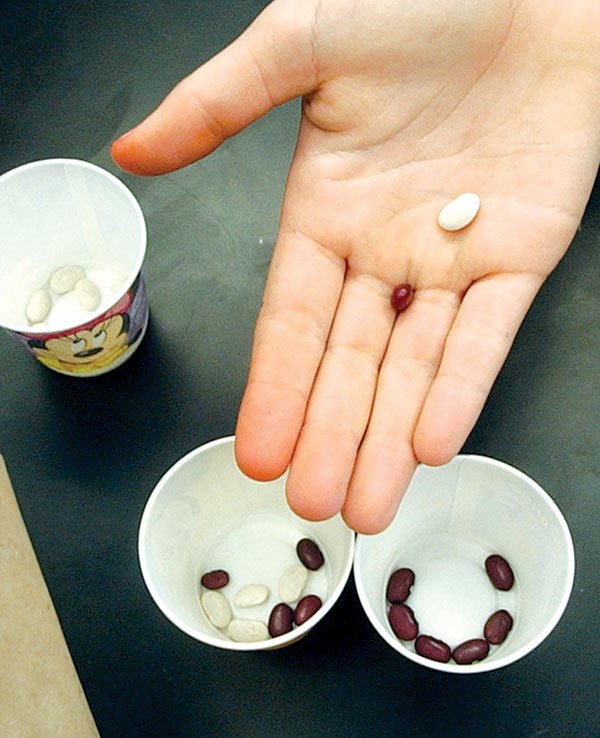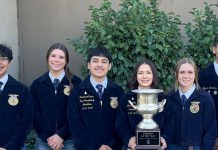Gilroy
– What type of grain does a goat prefer to eat? Do you remember
words better after seeing them in red or black ink? Why do people
shop using cash over credit cards? These are just some examples of
science projects students at Ascension Solorsano Middle School
developed for their schoolwide science
fair last month.
Gilroy – What type of grain does a goat prefer to eat? Do you remember words better after seeing them in red or black ink? Why do people shop using cash over credit cards? These are just some examples of science projects students at Ascension Solorsano Middle School developed for their schoolwide science fair last month.
Almost the entire student body participated as part of a curriculum initiative to get all students involved. Teachers from every department offered their assistance, and one in particular was recognized for her efforts.
Dawn O’Connor, a life sciences teacher, was selected as the Most Promising New Teacher at the Synopsis Silicon Valley Science and Technology Championships in San Jose April 3.
“I was surprised,” she said. “The award was given because of the quality and caliber of the projects brought in.”
O’Connor took sixth and seventh graders Sean Bay, Erica Bianchi, Colin Gavin, Connie Kang, Shayne Kelly, and Michael Sacconi to the regional competition where Bay and Gavin won top honors.
“None of our kids had picked what I call basic-level science projects,” O’Connor said. “(The judges) said that for middle school, our kids had really good sample sizes for what they did.”
Bay received a certificate from the American Society of Civil Engineers for her project titled Colorful Memories … or not? And Gavin won first place in his category and second place in his grade level for his project, The Power of Greenhouse Gases. He is an alternate for the State Science Fair May 23 in Los Angeles.
Students at Solorsano spent the last three months researching and conducting their experiments for the April 12 fair.
“It’s been a collaboration of the entire school,” O’Connor said.
Because there is a lot more to science than simply conducting experiments, teachers from the language arts and math departments offered to help to review students’ research papers and data before they handed in their final projects.
Each student wrote a research paper, and used computers for word processing and developing graphs and charts.
The result: Polished projects of award–winning caliber.
But it isn’t always this easy.
O’Connor faces several challenges in her classroom every day.
There is a myth circulating throughout middle schools nationwide that science is … for nerds.
In the fall, O’Connor and her colleagues have students compile a list of all the stereotypes attached to science, and then systematically refute them. “Keep science cool. Debunk the myth,” she said.
The next problem is a little more difficult to fix.
Many of O’Connor’s students are English Language Learners or are below grade level with their reading. The vocabulary at times, can simply be too difficult too to keep everyone on the same page.
“If you spend too much time in the book you lose them,” she explained.
Therefore she utilizes a more hands-on approach. Students perform between four and five experiments monthly, which helps them actually “own the material,” she explained. This methodology allows students to visualize complicated material.
For example, explain natural selection and DNA gene sequencing to a classroom of seventh graders without losing their attention – not an easy task.
But throw some red and white kidney beans into a brown paper bag, give it shake and there you have it: An experiment called ‘Breeding bunnies’ and a classroom of 12-year-olds who understand recessive gene traits.
In this particular experiment, two recessive genes create a bald bunny, and in nature, a bald bunny is a dead bunny O’Connor explains. She teaches using both the scientific terminology, and infuses it with catch phrases students will remember such as “dead bunny in a bag.”
The reason is simple, if they can remember the phrase, they will remember why specific scientific processes occur.
A problem O’Connor has not encountered is one that has plagued middle school science classrooms for decades – a waning interest in science by female students.
“You watch (girls) around seventh grade, they stop putting their hands up,” said O’Connor who worked at magnet science school in San Jose years ago.
But four out of the six Solorsano students brought to the Synopsis competition were female, and in June three female students will attend Tech Trek, a science conference at Mills College sponsored by the American Society of University Women.
O’Connor just hasn’t witnessed the phenomena lately.
“Dawn has a way of working with young people,” Solorsano principal Sal Tomasello said. “We use her lessons to let other teachers go in and observe.”
Turns out, he wasn’t the only one who noticed.













